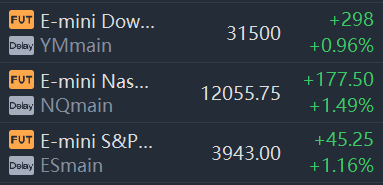U.S. stock futures pointed to a strong bounce for Wall Street on Friday, with sentiment getting a lift from a cut one of China's key lending rates. But investors are still facing yet another weekly loss.
VIX fell 2.7% and VIXmain rose 3.7% separately.
Gold rose 0.2% to $1845.1.
How are stock-index futures trading?
On Thursday, the Dow industrials and S&P 500 booked their lowest closes since March 2021, according to Dow Jones Market Data. The Dow fell 236.94 points, or 0.8%, ending at 31,253.13, after a 300 point gain at one point. The S&P 500 fell 0.6% to 3,900.79, and the Nasdaq Composite slipped 0.3% to 11,388.50.
Wednesday's dramatic selloff marked the worst day for the Dow and S&P 500 since June 2020.
What's driving markets?
Wall Street stocks took their cue from a strong Asian session, where the Hong Kong Hang Seng rallied 3.2% and the China CSI 300 index gained 1.9%.
The People's Bank of China on Friday cut its rate on five-year loans, aimed at shoring up weak housing sales by cutting mortgage costs. The country has been battling COVID outbreaks, with lockdowns in industrial hubs such as Shanghai blamed for weak factory and consumer activity data in April.
The S&P finished a step closer to bear-market territory on Thursday as the Russia-Ukraine war, a China slowdown, high inflation and rising interest rates have sparked concerns over corporate profits and economic growth.
Down 3% or more each, major indexes are likely facing yet another week of losses. The Dow industrials is set for its eight-straight loss, which mark its longest streak in history, according to FactSet.
The S&P 500 and Nasdaq are poised for their worst losing streaks since June 2011 and November, 2012, respectively. Losses have come amid concerns about whether soaring inflation can be brought under control by the Federal Reserve without derailing the economy.
Earnings from major retailers this week, such as Walmart and Target reported disappointing profits, against a backdrop of rising expenses and inflation.
The U.S. data calendar is empty for Friday, but next week will bring another round of inflation data, personal consumption expenditure prices excluding food and energy.

